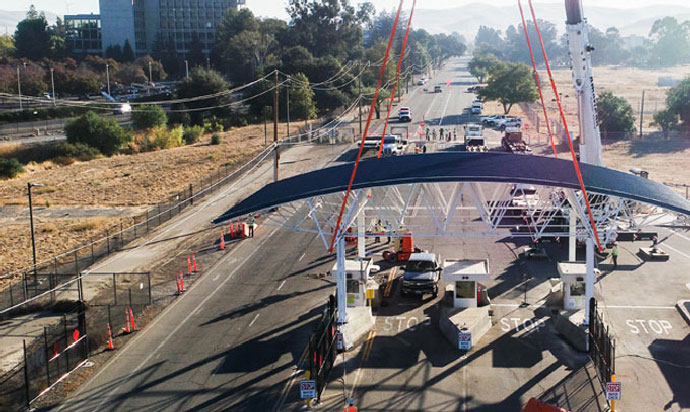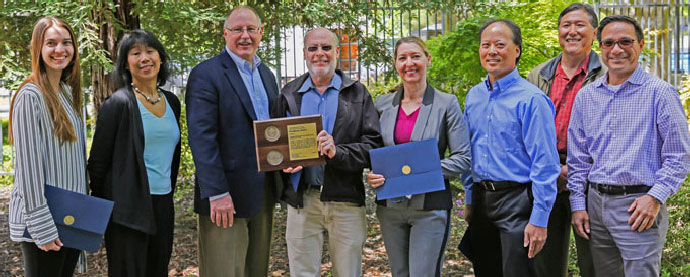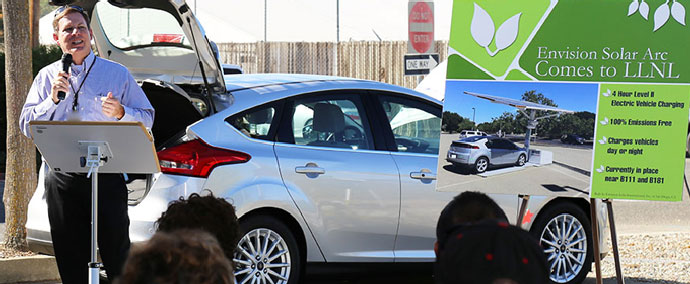Conducting safe, secure, and environmentally sound operations and modernizing the Laboratory’s infrastructure to meet evolving mission needs
Committed to the highest level of operational performance, LLNL implements best practices in environment, safety, and health (ES&H), and security. Management systems support continuous improvement in work practices. Prudent risk management coupled with active measures to prevent accidents ensures the safety of employees and the public. Investments are targeted to modernize the Laboratory’s infrastructure.
Attention to ES&H
Protecting workers and the environment and strengthening a strong safety culture continue to be primary focus areas for the Laboratory as high-visibility efforts continue on the W80-4 life-extension program, nuclear operations and waste disposal, work with hazardous materials, and a significant number of new construction and maintenance initiatives. In addition, overall positive ES&H operating results, performance metrics, and continuous improvement initiatives remain key facets of Livermore’s Integrated Safety Management System. This year, the Laboratory achieved International Organization for Standardization 14001 Environmental Management System recertification and successfully completed the Occupational Health and Safety Management System 18001 surveillance audit with zero non-conformances identified. In FY 2018, the Centers for Disease Control and Prevention inspected the Select Agent Center for three-year registration renewal. The results were best ever with no findings. The inspectors complimented LLNL for maintaining an “excellent program” and being a “model entity.” The Laboratory also garnered two DOE sustainability awards this past year.
LLNL continues to progress in implementing its new work planning and control process designed to ensure consistent Laboratory-wide practices, increase rigor and efficiency, and add value to work control documents. The goal is to convert all existing work control documents to the new system by the end of FY 2020. In addition, new initiatives such as “Take 5 for Safety and Security” videos continue to address injury risks including those relevant to traffic and construction safety; focusing on tasks; and slips, trips, and falls.
Effective and Secure Operations
In FY 2018, operations at Livermore were well managed, with notable achievements in many areas in addition to ES&H. The Laboratory conducted efficient, effective business operations and financial management. Individual and team efforts achieved many notable successes in nuclear operations, emergency management, and information technology management. Security performance was audited by a 35-member DOE Office of Enterprise Assessments team, which reported only three findings, representing the lowest number of findings issued to any site in the last two years. Importantly, with a continuing focus on ensuring the safeguarding and security of DOE assets, Livermore experienced a more than 36 percent reduction in security incidents in FY 2018 compared to the prior year. In addition, fence relocations at the Laboratory reduced the Limited Area footprint by 30 percent, which lowers security costs and helps meet office space needs.
Progress Toward Site Sustainability
Environmentally responsible work practices are ensured by LLNL’s Environmental Management System. These practices provide a systematic approach to identifying and reducing the environmental impact of Laboratory activities. The 2017 Site Annual Environmental Report (issued in October 2018) documents the Laboratory’s compliance with environmental standards and monitoring results.
Overall, LLNL is on track to meet many of its sustainability goals. The 2025 goals for clean and renewable energy usage, reduction of fleet petroleum use, acquisition of zero-emission vehicles, electronic stewardship, and pollution prevention/waste reduction are on track or have already been achieved. However, goals in areas such as energy intensity (including associated greenhouse gas emissions) and water usage reduction are challenged by mission requirements. In particular, high-performance computing demands substantial energy and water for cooling. The many aging facilities onsite limit options for improving overall building energy efficiency.
Maintaining and Reinvesting in Infrastructure
In FY 2018, LLNL completed nearly 80 capital projects valued at more than $100 million—nearly matching the investment made over the prior four years combined. Construction began in June 2018 on the $34 million Expand Electrical Distribution System (EEDS) Project to install new 15-kilovolt power cables that will eliminate single-point failures to current facilities and support planned development. EEDS is first in a series of line-item projects planned for the Laboratory (see Managing for the Future). Facilities and Infrastructure (F&I) revitalization is benefiting from the attention LLNL has placed on work safety and the development of enhanced tools for management of F&I and construction projects. Livermore made significant progress in rolling out the Enterprise Asset Management System and is at the forefront for implementing BUILDER, NNSA’s infrastructure life-cycle modeling tool. In May 2018, the NNSA associate administrator of Safety, Infrastructure, and Operations presented LLNL personnel three NA-50 Excellence Awards—for injury-free construction in FY 2017, the Applied Materials and Engineering Area Plan (see p. 19), and creation of the Cooling and Heating Asset Management Program (CHAMP). Developed at LLNL, CHAMP is an innovative contract instrument for NNSA sites to effectively manage air-conditioning and heating equipment needs.







